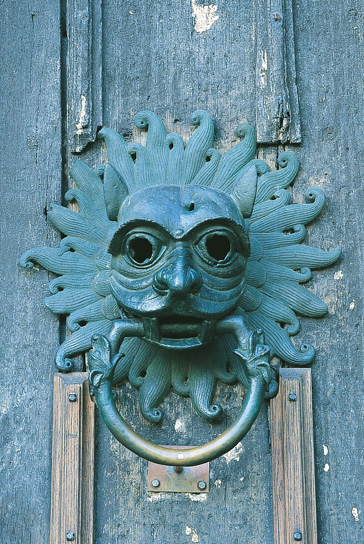The novel Fiona Whyte is writing as part of her PhD project is based on the life of the 7th century visionary St Cuthbert. She visited Durham Cathedral, the site of his burial, but found plenty of other stories there, both old and new.
The dragon-like Sanctuary Knocker on the north door of Durham cathedral marks the threshold of a sacred space. During the Middle Ages, people who had committed an offence could seek sanctuary by rapping on the knocker and would be given 37 days to reconcile with their enemies. After that they would be required to stand trial or leave the country. For me, the knocker is a reminder that this magnificent building is constructed as much from story as from stone. It raps on the door of the past and calls up the stories which are grounded, literally in some cases, within the body of the church.
I take a guided tour with Isabel, one of the volunteer guides. Isabel is a person conscious of the power of past and of story, and she narrates the history of the cathedral through a series of vignettes, centering them around the various pilgrimage stops of the church, interlinking the present with the past and always making her listeners alive to the continuing presence of those who built the stories.
We begin our pilgrimage in the nave with an account of the origins of the cathedral. It starts on the Holy Island of Lindisfarne where Cuthbert was prior and bishop. Due to Viking threats, the monks abandoned the island in the ninth century, taking with them the uncorrupted body of St. Cuthbert, the head of King Oswald, the bones of St Aidan and other treasures. They settled at Chester-le-Street, remaining there until 995 when further Norse threats caused them to move again.
At one point in this next part of their journey the cart bearing Cuthbert’s coffin became stuck in the ground and could not be dislodged. Then, providentially, one of the brethren overheard two dairymaids discussing the whereabouts of a lost cow, believing it had wandered to ‘Dunholme’. Taking this as a sign from Cuthbert, the monks now easily moved the cart and set off for Dunholme where they began the construction of Cuthbert’s final resting place, and where, presumably, the dairymaid found her lost cow. So Durham cathedral is not so much the home of Cuthbert’s shrine, but a shrine around which a great church was built.
A black marble line runs across the nave. This was the line beyond which in medieval times women could not go. In response to this, Bishop Hugh le Puiset – an enlightened man for his time, according to Isabel – ordered the construction of the Galilee or Lady Chapel where women could worship. The tomb of the Venerable Bede, who wrote a Life of St Cuthbert, lies here. Isabel tells us how a monk called Alfred, annoyed by the lack of veneration shown to Bede in his own monastery at Jarrow, removed (or stole, depending on your interpretation) the body in 1022 and had it buried in Durham cathedral where the great historian might be accorded the respect he deserved.
Another stop takes us to the Quire and the throne or cathedra of the Bishop of Durham. This throne was built by Thomas Hatfield, Bishop of Durham (1345-81), clearly a rather proud man, as at the time his throne was claimed to be the highest in Christendom, higher even than the pope’s throne in St. Peter’s in Rome. This highly decorated work served also as Hatfield’s tomb.
Not all the stories and stops are rooted so deeply in the past. When we come to the breath-taking Pietà, a wooden sculpture by local artist Fenwick Lawson, Isabel recounts another story. The sculpture was loaned to York Minister in 1984. That same year David Jenkins, known for his controversial views on the Virgin Birth and the Resurrection, among other things, was appointed bishop of Durham. Two nights after his consecration York Minster was struck by lightning and went on fire, causing the sculpture to be singed and splattered with lead. This was interpreted by some as divine disapproval for Jenkins’ views, though as one of my fellow pilgrims (who just happens to be a volunteer guide in York Minster) remarks: it was a bit tough on York! However, the view of some was that far from damaging the work, the heaven-sent fire had actually enhanced the sculpture, and Lawson decided not to carry out any remedial work on it.
An even more recent story focuses on the stained glass window near the north door. Entitled “Daily Bread”, this work, designed by Mark Angus, is a gift from the local Marks and Spencer’s staff and is an abstract representation in aerial view of the Last Supper.
Once, when taking a group of children on a tour, Isabel asked them to suggest which of the circular shapes representing the apostles might be Judas. The children were a bit flummoxed, but one little boy quickly worked out the answer – it was the green one, of course, because Judas grassed on Jesus!
The pinnacle of the visit for me takes place at Cuthbert’s shrine. He lies behind the high altar beneath a simple stone slab that bears his name in Latin: Cuthbertus. The head of King Oswald lies with him. The shrine is quiet and still, a place for solemn contemplation, and Isabel does not accompany us up the steps that lead to it.
This is not a place where stories are told, it seems, but rather where their meanings are meditated on. I light a candle and think about the many stories I have read and heard about Cuthbert and this great cathedral. I wonder where my story will fit into it all, but that is another day’s work.


